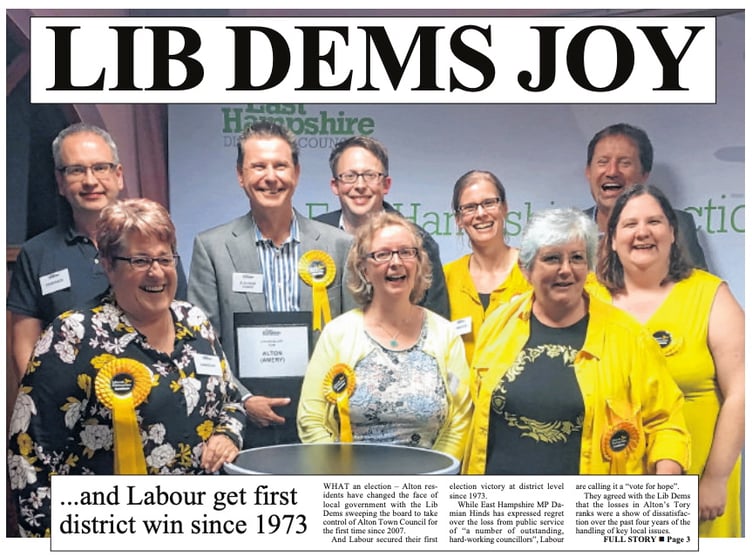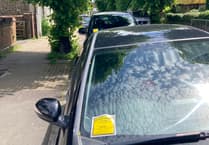The countdown to the May 4 local elections begins today (Thursday) with the anticipated publication of a formal ‘notice of election’.
This sets in motion a six-week build-up to polling day, with a full slate of town and parish, and borough and district council seats up for grabs across the area.
A final list of candidates will be confirmed on April 5 and eligible voters asked to register by April 17 and apply for postal votes by April 18.
It will also be the first election in England in which voters must show Voter ID at polling stations.
To kick off our election coverage, here is a look back at what happened in the eventful 2019 polls in Waverley and East Hampshire:
Waverley
Waverley Borough Council was left a ‘hung council’ after a groundswell of votes for the independent Farnham Residents party in Farnham, and for the Lib Dems in Haslemere, as well as a strong showing by the Lib Dems in Godalming.
Independent Nikki Barton also won a significant victory in the Haslemere county council by-election, with the ruling Conservative group also losing its majority on both Haslemere and Farnham town councils.
The Tories did though fare better in the rural areas and remained the party with the most seats at Waverley. But soon after the 2019 poll, the Lib Dems and Farnham Residents joined forces with Waverley’s new scattering of Labour and Green Party councillors to form a ‘rainbow’ ruling coalition.
East Hampshire
In the 2019 local elections in East Hampshire, the Conservative Party won 32 seats to retain control of the district council but suffered significant losses – with the Lib Dems winning seven seats, Labour two and independents two.
Speaking at the time, the council’s Conservative leader, Richard Millard, blamed national failures for the losses and said local concerns were not to blame.
Most of the losses came from Alton, where a raft of Lib Dem (pictured) and Labour candidates were elected to the district council and Alton Town Council (ATC) saw a significant shift, as the Lib Dems took control for the first time since 2007.
But there was also big change in Whitehill & Bordon, where the Whitehill & Bordon Community Party swept the board in the Whitehill Town Council election, winning all 15 seats.
Key dates and deadlines
The most important date ahead of polling day on Thursday, May 4 is the deadline for voter registration on Monday, April 17.
Make sure you register before then if you want to vote in the local elections.
But below are other key dates and deadlines, in what is sure to be a busy few months for local election officials and candidates:
- Publication of notice of election: Thursday, March 23
- Receipt of nominations, withdrawal of candidate, and appointment of election agents: 4pm, Tuesday, April 4
- Publication of notice of election agents: 4pm, Tuesday, April 4
- Publication of statements of persons nominated: 4pm Wednesday, April 5
- Last date for voter registration: Monday, April 17
- Receipt of postal vote applications: Tuesday, April 18
- Publication of notice of poll: Tuesday, April 25
- Receipt of proxy vote applications and voter authority certificates: 5pm, Tuesday, April 25
- Deadline for appointment of polling and counting agents: Wednesday, April 26
- First day to issue replacement lost postal ballot papers: Thursday, April 27
- Day of poll: 7am to 10pm Thursday, May 4
- Last day to issue replacement postal ballot papers and receipt of emergency proxy vote applications: 5pm, Thursday, May 4
- Return of election expenses: Thursday, June 8.
First election when voter ID is required to vote
A new requirement to show photographic ID at polling stations comes into force this year and will apply for the first time at English local elections in May.
This was introduced by the government in 2022, which claimed it would protect against voter fraud.
However, critics including trade union Unison have described the requirement as a form of “voter suppression” and a “threat to our democracy”.
Critics have warned that it will discriminate against marginalised groups and may prevent millions from voting.
The Labour Party has labelled the plan “vote rigging”.
Acceptable forms of photo ID include a passport, a UK driving license, a European Union or European Economic Area identity card, a photographic identity card bearing the national PASS hologram, a Ministry of Defence identity card, or a UK biometric residence permit.
If you do not have an accepted photo ID, you can apply for a free Voter Authority Certificate. This service is available to those who no longer look like the photo on their ID, whose name on their photo ID is different from their name on the electoral register, or those who do not have accepted photo ID.
To apply for a Voter Authority Certificate, you will need a recent digital photo of yourself and your National Insurance number.
If you do not have a National Insurance number, you can provide other documents to prove your identity, such as a birth certificate, bank statement, or utility bill. See here.





Comments
This article has no comments yet. Be the first to leave a comment.